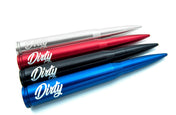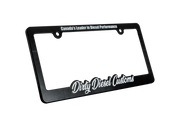The 6.7L Cummins engine was first introduced halfway through 2007 in the Dodge Ram Heavy Duty Pickups. This was the first Cummins in the pickup line to offer a Variable Geometry Turbocharger (VGT). A VGT turbo has many advantages such as a decrease in turbo lag while taking off from a stop, integrated exhaust braking, and infinite adjustment to load demand while driving. However, the downside to this turbo is a common failure that the turbo sees. We get countless calls about Cummins VGT failure, and usually, the first sign you’re going to notice is that you’ll suddenly have no exhaust brake.
How it works
VGT is offered in all-new diesel pickups, and each manufacturer controls their turbo in their own way, but the common function is to control the exhaust housing size, which in turn will control how much exhaust pressure is forced to turn the turbine wheel of the turbocharger.
Think of it like a garden hose, when the tap is all the way on, the water shoots out the hose a couple of feet but that’s it. Put your finger over the end of the hose, and you can get it to shoot halfway across your lawn. Even though it’s the same amount of water coming out, you’ve created a lot more force by controlling the size of the opening. This probably isn’t how the engineers would explain a VGT, but you get the idea.
If you were to pull apart your Variable Geometry Turbo from your Cummins you’d find a steel ring attached to a bunch of fins (or vanes as they’re called in the automotive world). As the steel ring rotates, the vanes move closer or further from the turbine wheel inside the housing creating more or less pressure between your engine and your turbo. This is controlled by an electric actuator on your turbocharger that controls the movement of this steel ring - this actuator is monitored by your engine's computer system. When you take off from a stoplight, the vanes are pushed tight against the wheel forcing all the exhaust pressure to drive the exhaust turbine. This increase in pressure builds boost faster and harder - once you get up to speed the actuator pulls the vanes away from the wheel and allows some of the gas to slip around the turbine without forcing it. Throughout your drive, your ECM is constantly monitoring your exhaust pressure and adjusting the vanes in your turbocharger to ensure that it stays in spec. This is actually how the integrated exhaust brake works on the Cummins engine. When you let off the throttle, the vanes move in as close as they can to the turbine wheel, by doing this, the turbo is creating immense pressure to hold you back while decelerating.
What fails?
All the features above sound great, and they really are, but it’s a system with many intricate moving parts that rely on each other to function properly. Typically, we see two common issues with the VGT on the Cummins engine; either your steel ring inside the turbo gets stuck or the actuator fails and cannot communicate with the computer anymore. This can cause any number of issues on your Cummins but the most common thing we hear is that the customer is having an issue with their exhaust brake. Either a sudden loss of their exhaust brake or their exhaust brake will stay activated even when accelerating.
This isn’t just an inconvenience, it can be devasting for your engine as it’s essentially forcing as much pressure as you can at the turbo, and if it’s stuck closed it will create massive spikes in pressure between the engine in the turbo. This can very quickly cause a blown headgasket as all that pressure needs to go somewhere!
Can I fix it?
A lot of times people will want to take the turbo out, split it apart, and clean the steel ring and housing. This can help for sure, but most of the time it will not permanently fix the issue. This can buy some time, but do you really want to pay someone to pull a turbo out and then 2 or 3 months down the road, pull it out again to install a new one? If you are doing it at home in your garage and you’ve got some time, sure it’s worth a shot, but to pay a shop to do it can get pricey, especially with no guarantee of fixing the issue.
How much is this going to cost?
Now for the painful part! These turbochargers have some great features, but it comes at a price. A new stock replacement turbo will cost you around $3500 CAD just for the replacement turbocharger (depending on where you get it) and then you’re looking at 6 hours of labor for installation.
That’s a lot of money to spend on a stock replacement. Sure, the actuators have been updated, and yes, they are working better now but a replacement turbocharger is not bulletproof. We have seen these fail as well. Fortunately, a few companies have released a variety of different turbochargers that are a direct replacement for your stock VGT.
What one do you choose? Well, it depends on a few different factors.
Upgraded Stock VGT
Your first option is the upgraded VGT that will drop right in place of your stock turbo, but give you increased performance and longevity.
BD Diesel & Fleece Performance both offer upgrades for the 6.7L Cummins. BD Diesel offers the Screamer Turbo and Fleece offers their signature Cheetah Turbo. Both BD & Fleece take the original Holset turbo and machine the compressor and turbine housing and replace the wheels with a bigger and more efficient design. The Screamer & Cheetah will increase flow while simultaneously decreasing the exhaust pressure. These turbos will support up to 650HP while lowering your exhaust gas temperatures (EGT’s) by simply increasing the overall efficiency of the turbo. Both great options and they are priced a little over the stock replacement and come with a core charge, which you will get back when you send in your failed turbo back.
No more VGT
The other option out there, which many companies offer a kit for, is to get rid of the VGT design and install a fixed geometry turbo as the old 5.9L Cummins offered. These kits normally will cost less and include a lot more parts for the money you’re spending, but the main reason people shy away from these is the loss of your exhaust brake. If that is your main reason, don't run away yet because you can always checkout some aftermarket Exhaust Brake options. With the custom tuning available today, if you pick the right sized turbo, these kits will spool up as quickly as stock, but perform much better in the top end. The fixed geometry turbocharger also creates much less exhaust pressure and will drop your exhaust gas temperatures significantly. These kits are very popular, but the 100 different turbo options can make it a bit confusing when making your decision. If you’re unsure, contact us and we can help you filter through all the options and find the right setup for your Cummins.
The first mistake everyone makes is buying a turbo that’s too big for their truck. Everyone wants to have a big turbo, but nobody wants to deal with the downside of going too big. By buying an oversized turbo for your application, you will actually lose performance and increase exhaust temperatures. Big turbos are great for big horsepower, but for 90% of people, a nice all-around size will make it much more enjoyable to drive and still give you more power and performance.
3rd Gen Style Setup
BD Diesel’s Iron Horn turbo line is a great upgrade and an affordable option to the VGT woes. This kit replaces the exhaust manifold and turbo, but bolts right up to the existing exhaust. They offer everything from a 61mm up to a 69mm turbo with different exhaust housing options in each size. The different exhaust housings are as simple as this the lower the number, the tighter the housing, which means quicker spool up, but less flow at wide-open throttle. The higher the number, means slower spool up, but better flow at wide-open throttle.
The exhaust options will be listed in an AR number, normally 0.91 or 1.0, etc. The SXE361 turbo would be a great replacement for a completely stock truck looking to a bit of extra horsepower, but not much. The SXE363 turbo is a great upgrade for a guy who’s got custom tuning, some 50hp injectors, and still uses the truck for towing.
The SXE364 is for the guy who wants to upgrade his injectors, maybe race his truck on the weekend but still wants to tow his camper. This turbo will be a little bit slower to spool than stock, but still an efficient all-around setup. The SXE366 and SXE369 are for trucks with bigger injectors and looking for that high-RPM power gains. They will still work with stock injectors, but expect some lag and increased EGT at lower RPM.
2nd Gen Style Setup
Most companies are now making kits to set up your turbo the same way they fit in the 1994-2002 5.9L Cummins, this is called the 2nd Gen Swap. The exhaust manifold from a 98 truck will bolt right up to your 2018 or anything in between. So they replace the manifold, supply a turbo and a new downpipe to mate to your existing exhaust. Just like the 3rd gen style kits, these ones are offered with a variety of different turbo options just like above. Essentially, they will work just the same, but they come with a few more parts as the turbo sits in a completely different spot. You will need to replace some coolant lines, new oil lines to the turbo, new air intake, intercooler piping, exhaust pipe, etc. These kits will cost more than the 3rd Gen style, but are still comparable to the stock replacement, depending on who’s kit you buy. These kits will let you get up into the S400 series turbo’s which can support up to the 800-1000hp range if that’s what you’re looking to get to.
Adding an Exhaust Brake.
It’s no secret that one of the best features of the 6.7L is the exhaust brake built into the VGT, and a few innovative companies have come up with solutions to this. Fleece Performance has developed an electric exhaust brake that will connect to your 2nd Gen style turbo and work with the factory button on the dash. You will still get the nice features of the stock programming, like quick warmup in the morning and the brake will kick off in the event of wheel slip through the ABS computer. BD Diesel also offers turbo-mounted and remotely mounted exhaust brakes that can be integrated with the factory controls. Both systems work very well and can come in very close to the same price as a stock replacement turbo.
This is a lot of info compressed into a few pages, but hopefully, you will find it helpful when it comes time to upgrade or replace your 6.7L Cummins turbocharger. With all the options out there, it can be overwhelming and difficult to make the right choice but no matter what you are looking to get out of your truck, there is a perfect option out there for you. If there is any further information you need to know, you can always call us, and we can help guide you through the process of replacing the turbocharger on your 6.7L Cummins.
BD Diesel
2007.5-2018 Cummins Holset VGT Actuators (1045922 & 1045923)







